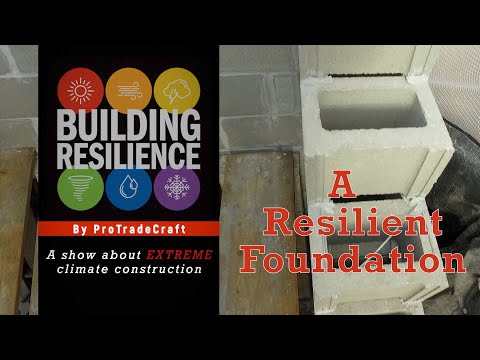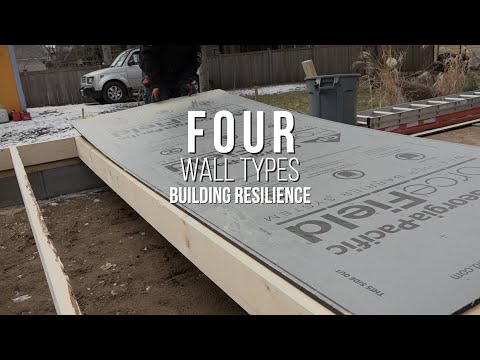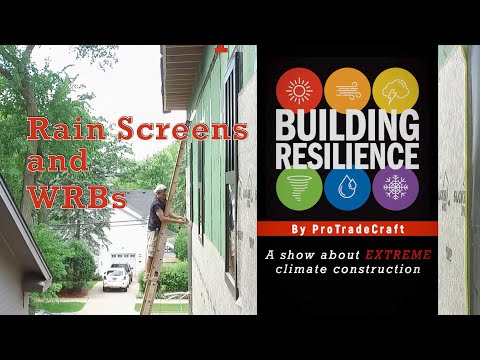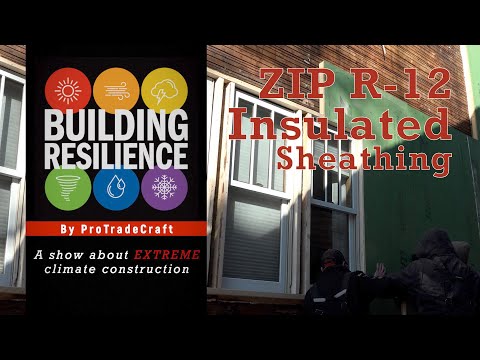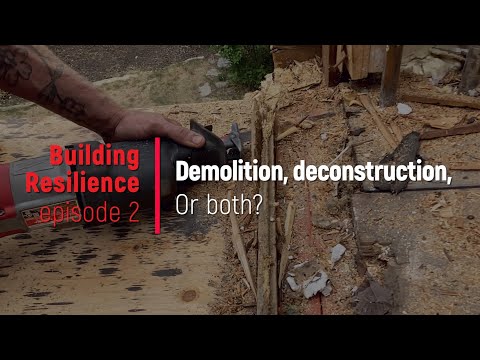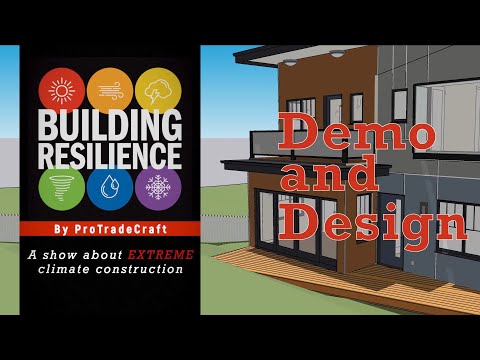ZIP System R-12 insulated sheathing covers a regularly framed wall, a shear wall, and a firewall
Last time on Building Resilience, we were inside a well-defined hole, trying to keep it warm. And learning about frost heave in the process.
We also filmed Michael competing with the wind for the plastic’s attention. In the p[rocess, we learned what sand boulders are: frozen chunks of wet sand.
They’re great for holding down the plastic, but the same mechanism could cause frost heave and completely sabotage our winter construction efforts.
"Because the water gets into the sand so quickly, it would freeze right around our footing and potentially under the footing, and soils will heave here, and that would wreak havoc on the entire structure.
So, it’s super-critical that we tent. Second is because we need to come in and put in some rock, some more insulation, we’ve got to pour a slab down there..."
Speaking of the slab, it is going to be isolated from the ground, so therefore, warm and dry
...Then, across the entirety of the floor, we have three inches of insulation for R-15.
We’re really just looking to make sure there’s no thermal transfer through the footing itself here into the Earth.
And at this corner here, we’re already at R-15 on the other side, so it’s a very warm corner. We’re not going to see any of those conditions where you have weird condensing corners taking place on the slab. It’s a super-simple detail, it works amazingly, and the slab doesn’t need in-floor heat to be warm.
Because it’s not losing heat to the ground and to the walls, just heating this room, the slab will take on some of that heat, kind of like a giant radiator and throw it back to you, like a T-mass (thermal mass) type of thing.
...So, that’s our floor.
And that brings us to where we are now:
The old addition is off the back of the house and in the recycle bin out front. The recycle bin out front is on the truck, and the truck is headed to recycle heaven. Or someplace.
Now it’s time to frame a new addition atop the foundation we were sitting in last time. They’ll frame a new floor and walls atop the new foundation, and the exterior sheathing, Zip R-12 insulated sheathing, will cover the new and existing structures, spanning the connection.
A unique problem with winter remodeling is heat flow. From frost heaving to frozen pipes, to uncomfortable homeowners, and miserable workers, it’s important to keep the inside warm and the outside out.
One of the challenges in Minnesota is keeping things war. We’ve got a furnace sitting down in the basement that we excavated. And we’ve got a little bit of heat that is being piped up into this space. But then we have all of these window openings, and with this assembly, it doesn’t make sense to sheethe over the windows and go back and cut them all out, that would not work.
So, we have openings, and luckily we have a bunch of ½-inch foam on site that we were able to nail up over the windows and keep the space warm.
The interesting stuff in here is mostly on the structural side of things, we’ve got a piece of steel running above my head that drops onto a nice PSL column off to the side.
We were working around the existing chimney, we did a lot of really cool tile work, we wanted to preserve the tile work, so that meant we had to preserve the chimney, and that meant that we ended up with a bunch of additional LVLs that frame around—basically like girders that go around the chimney over here.
This is our balloon-framed stairwell. This is original to the house, it’s actually a cantilevered balloon-framed stairwell structure. In 25 years, I have never seen anything quite like it. It had sagged a little bit, so we jacked it back up, it’s going to get braced below. But again, our floor framing had to run independent of it.
It’s fairtly unique how much of our floor framing is not running back to the house like it would in typical construction.
On the second floor, there are basically three walls butting the existing structure. Each wall has very different jobs and very different requirements, so the construction of each is very different.
On this wall we’ve got our ZIP R-12 over 2x4 framing. We’ll finish it out on the other side with Benjamin Obdyke rain slicker than then AZEK ¾ in. PVC panel system on top of that.
This wall is our wall type 2. It’s a shear wall. Anmd we have OSB on the outside of this wall as well as the inside of this wall and then we have ZIP System R-12 outside of that. So essentially, we have three layers of 7/16-in. OSB on this wall. It’s heavy, it’s not going to move, and that’s important because hanging from this opening is going to be a giant glass box.
We are super excited about what’s going to happen here. It’s framed a little bit differently, its got some built-up six posts on either side, this is =our shear wall. We don’t have out ZIP R-12 down below, burt we have it on this section of wall, so you’ll see how it all comes together.
But through this opening, Marvin’s come up with their take on a bow/bay window deal. A big steel frame will bolt to the side of the house and we’ll get glass on four sides. So you’ll be able to sit here with a nice doug fir bench sticking two feet out into space staring into this beautiful tree.
So we have 2x6 framing really in this section from this wall to this wall and down to where my foot is. This portion alone will be insulated from the interior. There’s just not a good way to insiu;ate on the outside. It’s an 800-pound window and we just couldn’t have the compression of the foam as part of that mix.
OK, so you’re probably wondering why id this yellow and not green? What is this DensGlass doing on this house?
The answer is proximity to the property line and the adjacent house. Fire code requires that we install a layer of gypsum between our framing and our cladding.
Now DensGlass Gold interestingly enough, was our stand-by go-to material for many many years before we started using the ZIP products and the ZIP R-12.
It’s super durable and its rated for exposure. We actually like using this product quite a biot, so its an obvious candidate for us to put between the layers here.
So this is just a fireproofing layer, nothing more. It will get buried underneath the ZIP R-12, which as you can see, is working its way up the wall.
With the three main wall types defined and mostly built, we’re going to jump up onto the roof next time. But don’t worry; it’s mostly flat.
When we jump up there, we’re going to discover that parts of it are spongy,
So this old balloon-framed house, we knew basically how they built it, but we weren’t 100% sure until we opened it up. We had a bunch of theories about how they built this roof structure and none of them were right.
...so we need to break out the demo bucket again and get it ready to frame a slightly pitched roof over it. After it’s framed, we’ll grab some ZIP System roof sheathing off the pile, put it on the line, and nail it.
